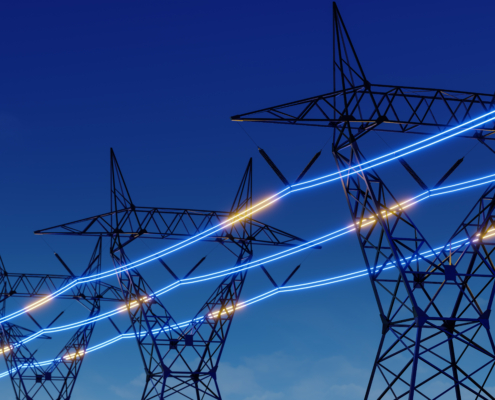October 16, 2025
As we navigate the global transition toward cleaner, more resilient energy systems, the condition of our aging infrastructure stands as both a formidable challenge and a critical opportunity.
After decades in the industry, I am keenly aware that the grid that powers our homes, businesses, and communities was built long before the rise of renewable energy, the digitization of power systems, or the growing impacts of climate change. And yet, this legacy infrastructure forms the foundation of our energy future, presenting us with a unique opportunity and an exciting challenge.
Understanding the Risks
The risks posed by aging infrastructure are as widespread as they are urgent. In many regions, the power grid was not designed to accommodate today’s dynamic demands, whether it’s the exponentially growing load from AI, data centers, and electrification; the variable nature of renewable energy sources; or the need for enhanced cybersecurity.
Aging transmission and distribution lines—over 70% of lines in the United States are over 25 years old—are more prone to outages, especially under the strain of extreme weather events, which are becoming more frequent due to climate change. Equipment failures (some rooted in infrastructure that’s been in service for 40 to 70 years) can lead to cascading blackouts, costly disruptions, and even serious safety concerns. The 2021 Texas winter storm, the recurring wildfires on the west coast, and the increasing intensity of hurricanes on the east coast are stark reminders of the stakes at hand.
What’s more, older infrastructure can serve as a bottleneck to progress. As we seek to integrate more solar and battery storage into our energy systems, for example, outdated grid components often lack the flexibility and control needed to manage distributed energy resources effectively. This not only slows the pace of decarbonization but also hampers our ability to build more resilient and efficient energy systems.
A Moment of Opportunity
In all challenges, I choose to see opportunity. While the need for grid modernization is urgent, it also presents an inflection point: we now have the chance to not only upgrade the hardware, but also our entire approach to energy generation and distribution.
Reimagining infrastructure today means designing for tomorrow’s needs. Technologies like smart transformers, grid-interactive buildings, and AI-enhanced predictive analytics can help utilities operate more efficiently, anticipate outages, and balance supply and demand with real-time precision. These upgrades can reduce emissions, improve system reliability, and lower energy costs for consumers.
To ensure a stable and reliable energy supply, it is also crucial to incorporate baseload distributed power generation that operates 24/7. This includes resources such as combined heat and power (CHP), fuel cells, gas turbines, small nuclear reactors (SMR), hydropower, geothermal, and solar-plus-storage systems, which can provide consistent power regardless of weather conditions or time of day. Building firm generation capacity is essential to meet continuous demand and support the integration of intermittent sources like solar and wind. At the Los Alamitos Joint Forces Training Base, a combination of distributed resources paired with a microgrid ensures that the base’s role as southern California’s emergency response hub can go uninterrupted when it is needed most.
By decentralizing power production and management, we reduce our reliance on long, vulnerable transmission corridors and increase local energy resilience. For remote communities (such as those surrounding Juneau, Alaska), military installations, and critical infrastructure such as hospitals or industrial facilities, distributed systems provide a vital lifeline during broader grid failures. Across the board, these systems are an essential augmentation to our aging grid infrastructure, increasing energy security, and reducing costs as we work to develop innovative solutions for the future.
The Role of Public and Private Collaboration
No one sector can tackle this transformation alone. Federal and state investments, such as those supported through the Bipartisan Infrastructure Law and the Inflation Reduction Act, are helping to kickstart long-needed upgrades. But as recent events have shown, these are not guarantees. Real progress will come from strong public-private partnerships that blend technical innovation with on-the-ground execution.
At Ameresco, we’ve seen firsthand the power of such collaborations. Whether it’s modernizing Federal buildings with energy efficient technologies or integrating solar and battery storage into utilities and municipalities, infrastructure projects offer the chance to embed sustainability and resilience at the core of community development. In many cases, we can deliver these improvements with no upfront capital by utilizing energy savings performance contracts (ESPCs) to pay for upgrades over time, an approach that’s both financially and environmentally sound.
Preparing the Workforce for What’s Ahead
As infrastructure evolves, so must the workforce behind it. There is a growing need for engineers, electricians, systems integrators, data analysts, and energy consultants who can bridge the gap between traditional utility operations and emerging clean technologies.
Through partnerships with schools, trades programs and vocational centers, we’re helping to prepare the next generation of workers for careers in energy, careers that are not only in high demand but critical to our nation’s future. Programs like the Path to Trades Initiative in St. Louis or projects affording students hands-on experience like with the Tri-County Career Center in Ohio are already showing what’s possible when students are given early exposure to the clean energy economy and the chance to learn by doing.
Looking Forward with Purpose
Modernizing our aging infrastructure is no small feat. It will require investment, collaboration, and a willingness to rethink the status quo. But the payoff is substantial: a more resilient grid, cleaner air, lower energy costs, and new economic opportunities for communities across the country.
We have the tools. We have the knowledge. And we have urgency. What we need now is the collective will to act, not just to replace what’s old, but to build something smarter, stronger, and more sustainable.
# Originally published on LinkedIn. #

